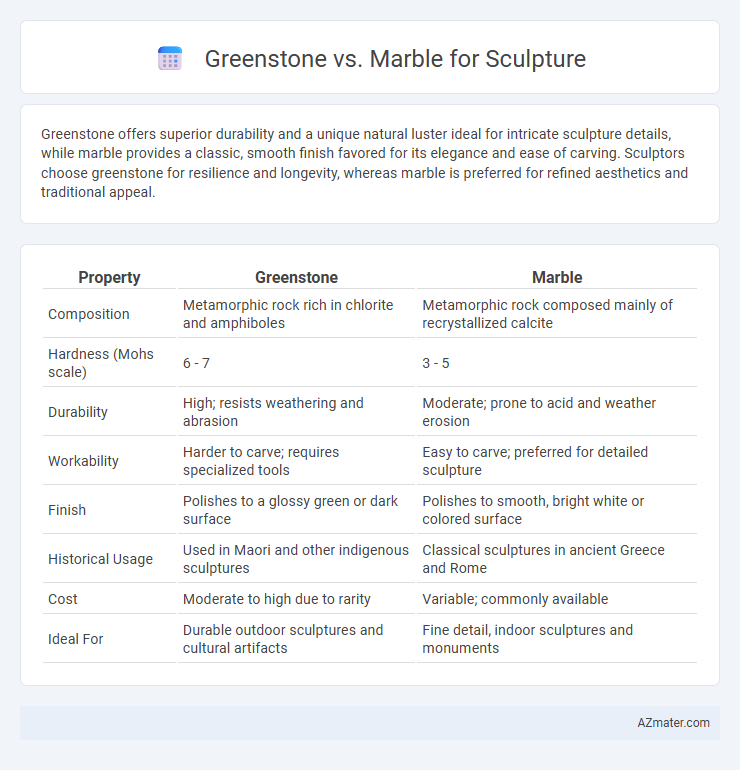Greenstone offers superior durability and a unique natural luster ideal for intricate sculpture details, while marble provides a classic, smooth finish favored for its elegance and ease of carving. Sculptors choose greenstone for resilience and longevity, whereas marble is preferred for refined aesthetics and traditional appeal.
Table of Comparison
| Property | Greenstone | Marble |
|---|---|---|
| Composition | Metamorphic rock rich in chlorite and amphiboles | Metamorphic rock composed mainly of recrystallized calcite |
| Hardness (Mohs scale) | 6 - 7 | 3 - 5 |
| Durability | High; resists weathering and abrasion | Moderate; prone to acid and weather erosion |
| Workability | Harder to carve; requires specialized tools | Easy to carve; preferred for detailed sculpture |
| Finish | Polishes to a glossy green or dark surface | Polishes to smooth, bright white or colored surface |
| Historical Usage | Used in Maori and other indigenous sculptures | Classical sculptures in ancient Greece and Rome |
| Cost | Moderate to high due to rarity | Variable; commonly available |
| Ideal For | Durable outdoor sculptures and cultural artifacts | Fine detail, indoor sculptures and monuments |
Introduction: Greenstone vs Marble in Sculpture
Greenstone and marble are two popular materials in sculpture, each offering unique properties that influence artistic expression. Greenstone, known for its durability and rich, deep hues, provides a robust medium ideal for intricate carving and outdoor installations. Marble, prized for its smooth texture and translucency, allows for fine detailing and a luminous finish, making it a favored choice for classical and contemporary sculptures.
Historical Significance of Greenstone and Marble
Greenstone, prized by ancient Mesoamerican civilizations such as the Olmec and Maya, holds profound historical significance as it symbolized fertility, power, and spiritual connection, often carved into intricate ceremonial artifacts and sculptures. Marble, revered since classical antiquity by Greeks and Romans, embodies artistic legacy and durability, renowned for its use in iconic sculptures like Michelangelo's David, representing humanism and aesthetic perfection. Both materials reflect distinct cultural values and artistic traditions, with greenstone emphasizing spiritual symbolism and marble showcasing refined craftsmanship and timeless beauty.
Geological Composition and Characteristics
Greenstone, primarily composed of metamorphosed basalt rich in chlorite, epidote, and actinolite, offers exceptional durability and fine-grained texture ideal for detailed sculpting. Marble, a metamorphic rock predominantly made of recrystallized calcite or dolomite, provides a smooth, crystalline surface that enhances polish and translucency, making it favored for classical and refined sculptures. The dense, tough nature of greenstone results in greater resistance to weathering compared to marble's relative softness and susceptibility to acid rain.
Workability: Sculpting Techniques & Tool Compatibility
Greenstone, known for its fine-grained texture and moderate hardness, offers excellent workability for detailed carving using both traditional chisels and modern rotary tools, enabling smooth finishes and intricate designs. Marble, softer and more homogenous, allows for easier manipulation with hand tools like rasps and files, yet demands careful control to avoid chipping during fine detailing stages. Tool compatibility varies as greenstone requires diamond-tipped tools for precision, while marble responds well to standard steel carving instruments, influencing sculptors' technique choices and workflow efficiency.
Durability and Longevity of Greenstone and Marble
Greenstone offers exceptional durability due to its dense, fine-grained composition, making it resistant to weathering and erosion, which contributes to its longevity in outdoor sculptures. Marble, while prized for its aesthetic appeal and smooth texture, is more susceptible to acid rain and environmental degradation, potentially reducing its lifespan in exposed conditions. Sculptors seeking long-lasting works often prefer greenstone for its robustness, whereas marble is favored for indoor displays where its longevity is less compromised.
Aesthetic Appeal: Color, Texture, and Finish
Greenstone offers a vibrant range of green hues with subtle variations, providing a natural, earthy aesthetic that enhances the organic feel of sculptures. Marble is prized for its classic white, cream, or grey tones with intricate veining, delivering a timeless elegance and smooth, polished finish. The texture of greenstone is generally more granular and matte, while marble's fine grain allows for a refined, glossy surface, influencing the sculpture's visual depth and light reflection.
Cost Comparison: Affordability of Materials
Greenstone is generally more affordable than marble, making it a popular choice for sculptors on a budget. The availability of greenstone in certain regions reduces transportation and extraction costs, contributing to its lower price point. Marble, while often valued for its classic appearance and fine grain, tends to be more expensive due to quarrying, processing, and its high demand in luxury sculpture markets.
Environmental Impact and Sustainability
Greenstone exhibits higher environmental sustainability due to its natural abundance and minimal processing requirements, resulting in lower carbon emissions compared to marble, which demands extensive quarrying and energy-intensive polishing. Marble extraction often leads to significant landscape disruption and waste, while greenstone's durability and local availability reduce transportation impacts and resource depletion. The biodegradability of greenstone residues further enhances its eco-friendly profile, positioning it as a more sustainable choice for sculpture materials.
Famous Sculptures and Renowned Artists
Greenstone, prized in Maori culture, is famously used in intricate jade carvings such as the ceremonial weapons by New Zealand artists like Matahi Whaitiri. Marble, celebrated in Western art history, features prominently in masterpieces like Michelangelo's David, showcasing its smooth texture and durability favored by Renaissance sculptors. Renowned artists have preferred marble for its ability to capture fine details, while greenstone's cultural significance and toughness appeal to indigenous artists creating symbolic and spiritual works.
Choosing the Right Stone: Recommendations for Sculptors
Greenstone is prized for its durability and smooth texture, making it ideal for detailed sculpting and outdoor installations. Marble offers a classic aesthetic with fine grain and translucency, suitable for intricate indoor sculptures requiring a polished finish. Sculptors should consider the stone's hardness, workability, and intended display environment when choosing between greenstone and marble to achieve the desired artistic and long-lasting results.

Infographic: Greenstone vs Marble for Sculpture
 azmater.com
azmater.com